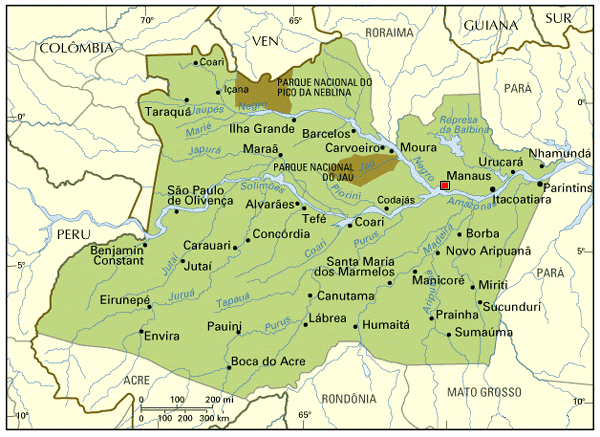Ads by Google
Map of Amazonas, Brazil
« Brazil travel information
« Back to Amazonas
 Amazonas is the largest Brazilian State, with 1,577,820 km2; itīs bigger than Germany, France, the UK and Italy combined; itīs slightly bigger than Alaska, and bigger than California and Texas combined.
Amazonas is the largest Brazilian State, with 1,577,820 km2; itīs bigger than Germany, France, the UK and Italy combined; itīs slightly bigger than Alaska, and bigger than California and Texas combined.
The Equatorial Line crosses the north of the State; climate is equatorial, very hot and very humid (see weather in Manaus).
The State of Amazonas has its name associated with the river Amazonas (the river cuts across the State) and the Amazon forest (the State is nearly entirely covered by the forest; the forest extendes to other States and countries); these names derive from the legends of the Amazon women, who would have been seen by the first explorers of the region.
The Amazon forest is one of the largest remaining continuous tract of nature in the world. Although it is well known that the biodiversity of the forest is one of the richest on earth, it is far from being completely catalogued.
Measured by lenght, river Amazonas is the second in the world, after the Nile, in Egypt. However, by volume of water, nothing comes close to the Amazonas: it is estimated that the Amazonas alone pours one fourth of all the water thrown into the oceans of the world.
The capital is Manaus; during the first few decades of the 1900s, when Brazil was the almost monopolistic producer of rubber in the world, Manaus was one of the most sophisticated cities in the planet; most of the largest buildings in Manaus (such as, for example, the Opera House) date back to this epoch.
Other important cities of the State are Parintins (the second in population, famous for its Parintins Festival), Tefé, Manacapuru and Itacoatira.
Rivers are an important means of transportation (all important cities are built by a river); there are modern, safe, well maintained boats for tourists, but the local population depends on large (for mass transportation purposes), old and insecure ships. Accidents are frequent. Given the width of the Amazonas, even ocean cruiser vessels can go easily go as far inside as Manaus.
Notice that travel lenghts are measured in days, and that moving upstream takes twice as much as moving downstream.
Back to Top